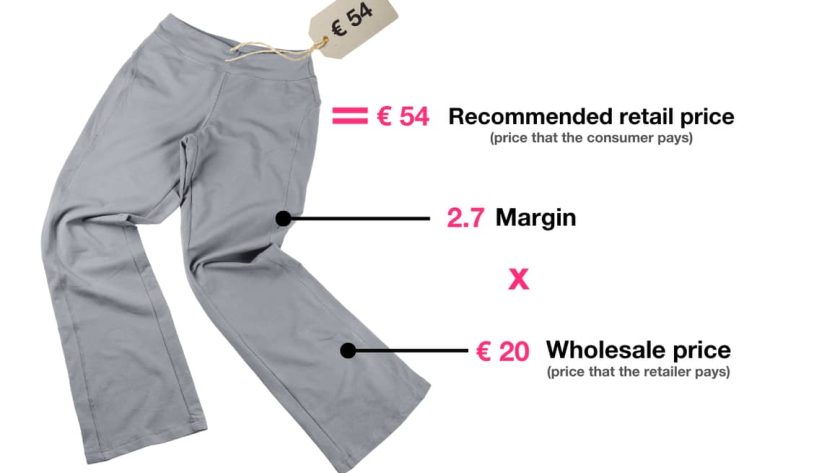On this page you will find key figures used in the fashion industry to monitor and optimise performance, such as sell-through, margin, and turnover, among others.
Retailers use numerical analyses to substantiate business decisions, such as making a purchasing plan and budget for the next fashion season.
“We sometimes compare choices for budgets and brands with buying shares of a company,” says independent Dutch retailer John Mulder of Mulder Mode to FashionUnited. “If a share performs well, you buy more; if a share is bad, you quit or trade less.”
Mulder adds: “As far as buying is concerned, this seems to be happening earlier and earlier, appointments in June/July for the following summer are no exception. If you had only sold 50 percent of the collection, you would miss quite a bit of data to be able to purchase properly. We therefore prefer to buy from the end of July/beginning of August in order to be able to substantiate the buying with as realistic a picture as possible.”
You can choose to read the article from beginning to end.
Or click on a term from the glossary (glossary A-Z) to go directly to it.
Glossary (A-Z)
We also deal with:
Sell-through / Sell-through percentage / Resell percentage
What does resale mean?
Resale represents how much of the purchased collection (read: the stock/inventory) the retailer has sold to its customer, the consumer.
How do you calculate the sell-through percentage? You divide the purchase value of items sold by the purchase value of the delivered items and multiply this by 100.
For example, if the purchase value of the items sold is 10,000 euros and the purchase value of the delivered items is 20,000 euros, then the sell-through percentage is (10,000 / 20,000) x 100 percent = 50 percent. This percentage tells us that half of the purchased stock has been sold in that period.
Over the course of a season, the sell-through rate or percentage is an important indicator of how clothing brands are performing, so that adjustments can be made. For example, retailers can decide to purchase additional items that are performing above average and exchange items that are not performing as well (so-called slow movers) from the brands for other products.
Aim for a 70 percent sell-through rate
Retailers also keep track of the resale of their entire collection. Retailers aim for a 70 percent sell-through rate before the sale begins. So they try to resell 70 percent of their entire collection to the consumer, for the original price (i.e. without giving a discount).
“Our experience is that it is increasingly challenging to achieve the 70 percent for clearance sales,” said store owner John Mulder of Mulder Mode. “The seasons sometimes start later (referring to the weather, ed.) and sales start earlier and earlier. With some clothing brands you are also tied to a certain budget, which can make it more difficult to realise 70 percent.” Nowadays, the sell-through percentage in fashion at the start of the sale is increasingly around 60 percent. “And this can therefore have a significant impact on the results.” (Because, if there is more clothing sold at a discount, this means less income for the retailer.)
The goal is to have a sell-through percentage of 90-95 percent by the end of the season – after the sale. (Because, keeping stock costs money, as goods quickly become less valuable. More on the written down value method, a depreciation technique later in the article, ed.)
Turnover rate
What is turnover velocity? What is turnover rate?
Sales rate and turnover rate are often used interchangeably. Both terms refer to the number of times the average inventory is sold in a given period, such as a season or a year. Turnover speed can be calculated at different levels, for example for category/product groups, brands or individual products.
How do you calculate the turnover rate? You divide the purchasing value of the turnover (this is the total cost price of all products sold in a certain period) by the average purchasing value of the stock (this is the average cost price of all products that were in stock for a certain period).
For example, if the purchasing value of sales is 100,000 euros and the average purchasing value of inventory is 25,000 euros, then the turnover ratio is (100,000 / 25,000) = 4. This means that the company’s inventory has been sold four times during that period.
In general, retailers strive for a high(er) turnover rate. A low turnover rate can indicate too much inventory or products that don’t meet customer demand and can lead to a lower profit margin.
For retailers, a higher turnover rate means that money is regularly coming in from the sale of products. This improves cash flow and can lead to a higher profit margin.
Gross profit margin / profit margin / margin
What is gross profit margin?
Gross profit margin, or gross margin, is the percentage of profit a company makes on the sale of products.
How do you calculate the gross margin?
You divide by the gross profit by the turnover excluding VAT and multiply this by 100.
For example, if a company has made 10,000 euros in turnover excluding VAT and the gross profit is 3,000 euros, then the gross margin is 30 percent. This means that the company has made a 30 percent profit on product sales.
Retailers generally strive for a high gross margin. A higher gross margin means that a retailer keeps a larger portion of the sales price as profit.
There are various ways in which fashion retailers can increase their gross margin, such as reducing purchasing costs (see purchasing costs).
Profitability / Return
What is profitability?
Profitability is a way of measuring how well a fashion company manages to make a profit with the resources it has (invested). Often, profitability is understood for all the clothing brands a retailer sells.
How do you calculate profitability? The key figure takes into account two important factors: the turnover rate and the margin.
You divide the gross profit of the turnover by the purchasing value of the turnover and multiply this by the turnover rate.
Suppose the outcome is a profitability of 20 percent. This means that the retailer has made a profit of 20 pence for every pound invested.
The higher the profitability, the more efficiently a company uses its resources to make a profit. Here too, the general aim is for a high return/profitability.
Sales share
What is turnover share?
Sales share is the percentage of a fashion company’s total revenue that is generated by a specific brand, product, category or segment. It therefore provides insight into performance.
How do you calculate turnover share? For example, you take the turnover of a fashion brand in a certain period (say a month, quarter or year), divide this by the total turnover and multiply this by 100.
Suppose the total turnover of a retailer’s clothing store last month was 50,000 euros and the turnover of brand ‘X’ in the same period was 10,000 euros. Then he divides 10,000 by 50,000 x 100 percent = 20 percent. This means that brand X was responsible for 20 percent of the clothing store’s total turnover in the past month.
A high revenue share may mean that a product or brand is popular and selling well, while a low revenue share may indicate less popularity and less demand in the market. But beware, “it does not mean that a small turnover share automatically means that a brand is performing poorly”, Dutch retail organisation INretail emphasises in its report ‘How do you prepare for the Fashion purchasing season?’. Some brands can make a smaller contribution to turnover, but are still important to the total offering of the store.
Margin (startmargin and netmargin)
What is a starting margin?
When people talk about margin, it is often about the buying margin or starting margin as it is called.
How do you calculate margin? Purchase price (excl. VAT) multiplied by the margin equals the sales price incl. VAT.
In fashion, the margin – also called the calculation number or factor – is often around 2.7. For example, a supplier, say a fashion brand X sells a pair of trousers to the retailer for 20 euros (i.e. it costs the retailer 20 euros to buy the trousers). Then you take the margin 2.7 and multiply it and you arrive at the recommended retail price. So these trousers are in the store for 54 euros.
The text continues below the visual
This factor is important to retailers because it gives them information about how much money can be made on the sale of the garment to the consumer. The higher the margin, the more money can be made. Provided the garments are actually sold.
Which brings us to net margin.
The net margin is more important than the starting margin, because it can be high but if the retailer doesn’t sell the item, it brings in nothing. Net margin is the margin after seasonal adjustments, i.e. after replenishment or withdrawing (of clothing from fashion brands, ed.) in response to the results. In other words, the actual margin, at the end of the season.
The text continues below the photo
Buying costs
Buying costs are the costs that a fashion retailer incurs when buying clothing and accessories. These are, of course, the costs of the products themselves, but also consider, for instance, possible import duties, transport and/or packaging costs.
Purchasing costs are an important part of a retailer’s total costs and therefore have a (major) impact on the profitability of the clothing store. (Because, sales – costs = profit/loss)
Inventory value
Inventory value refers to the value of the total inventory held by a fashion retailer. The inventory value is an important figure because it is directly related to the financial health of the company.
An inventory value that is too high can mean there is too much stock that is not being sold quickly enough, which could jeopardise the company’s cash flow. Too low an inventory value could mean that the company does not have enough stock to meet customer demand, missing out on potential sales.
Write-down stock
What is inventory write-down?
The accounting term write-down refers to reducing the value of the unsold clothing items in stock. After all, clothing is trend-sensitive, goods become outdated quickly and go ‘out of fashion’. The longer the product remains in stock, the less it is worth. Ultimately these products become unsellable.
For textiles and clothing in the Netherlands, mandatory depreciation percentages have been set by the tax authorities. “The depreciation percentages for women’s and men’s fashion and shoes differ,” says John Mulder. (In the UK, clothing, accessories and footwear are subject to the standard 20 percent VAT, however, zero rate VAT is applied to babywear, and children’s clothes and footwear, ed.)
Retailers try to minimise inventory write-downs / stock depreciation through effective stock management.
Sources:
– Interview with John Mulder, co-owner of fashion store Mulder Mode in Waddinxveen, June 1, 2023
– Website trade organisation INretail and the report ‘How do you prepare for the Fashion purchasing season?’ which was released for members on December 3, 2020
– Content from the FashionUnited archive and specifically the articles ‘Being an independent retailer: this is what it takes to run a fashion store’, January 25, 2023 and ‘What does a fashion agent do?’, November 24, 2022
– TMO Fashion Business School as attended by the author of the article
– Belastingdienst.nl ‘Valuation of stock in your company’, consulted in June 2023
– Gov.uk VAT rates on different goods and services, consulted in October 2023
– Parts of this article text were generated with an artificial intelligence (AI) tool and then edited.



